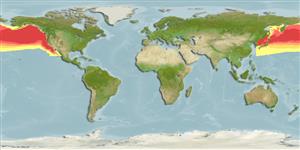>
Stomiiformes (Lightfishes and dragonfishes) >
Stomiidae (Barbeled dragonfishes) > Chauliodontinae
Etymology: Chauliodus: Greek, chaulios, chaulos, chaunos = to be with the mouth opened + Greek, odous = teeth (Ref. 45335); macouni: Named after Prof. J.C. Macoun, Geological Survey of Canada, a resolute pioneer of western Canada (Ref. 6885).
Eponymy: John C Macoun (1831–1920) was a self-taught botanist who emigrated from Northern ireland to Canada (1850). [...] (Ref. 128868), visit book page.
More on author: Bean.
Environment: milieu / climate zone / depth range / distribution range
Ecologia
marino batipelagico; distribuzione batimetrica 25 - 4390 m (Ref. 5610). Deep-water; 66°N - 23°N, 127°E - 106°W
Northwest Pacific: Navarin Canyon in the Bering Sea to Japan. Eastern Pacific: Gulf of Alaska to central Baja California (Ref. 35898) and the Gulf of California.
Size / Peso / Age
Maturity: Lm ? range ? - ? cm
Max length : 29.3 cm TL maschio/sesso non determinato; (Ref. 80637); peso massimo pubblicato: 23.35 g (Ref. 4525); Età massima riportata: 8 anni (Ref. 28499)
Short description
Chiavi di identificazione | Morfologia | Morfometria
Spine dorsali (totale) : 0; Raggi dorsali molli (totale) : 5 - 7; Spine anali: 0; Raggi anali molli: 9 - 14; Vertebre: 56 - 62. First dorsal fin ray much produced in a long filament terminating in a minute flap; adipose fin large, placed well back over posterior part of anal, higher posteriorly; pelvic fins long and narrow (Ref. 6885). No true gill rakers (Ref. 6885). Dark brown to black in color (Ref. 6885). Branchiostegal rays: 16-21 (Ref. 35898).
Migrate upward at night (Ref. 28499). Feed on small planktonic crustaceans, arrow worms and fish (Ref. 28499). Has photophores on belly arranged in a row (Ref. 2850). Oviparous, with planktonic eggs and larvae (Ref. 35898). Also caught with bottom trawls.
Eschmeyer, W.N., E.S. Herald and H. Hammann, 1983. A field guide to Pacific coast fishes of North America. Boston (MA, USA): Houghton Mifflin Company. xii+336 p. (Ref. 2850)
IUCN Red List Status (Ref. 130435: Version 2024-1)
Threat to humans
Harmless
Human uses
Pesca: pesca di sussistenza
Strumenti
Special reports
Download XML
Fonti Internet
Estimates based on models
Preferred temperature (Ref.
123201): 0.2 - 3.8, mean 2.4 °C (based on 409 cells).
Phylogenetic diversity index (Ref.
82804): PD
50 = 0.5020 [Uniqueness, from 0.5 = low to 2.0 = high].
Bayesian length-weight: a=0.00204 (0.00119 - 0.00351), b=3.16 (3.00 - 3.32), in cm total length, based on LWR estimates for this species & (Sub)family-body (Ref.
93245).
Trophic level (Ref.
69278): 4.5 ±0.4 se; based on diet studies.
Generation time: 3.1 ( na - na) years. Estimated as median ln(3)/K based on 1
growth studies.
Resilienza (Ref.
120179): Medio, tempo minimo di raddoppiamento della popolazione 1.4 - 4.4 anni (K=0.35; tmax=8).
Fishing Vulnerability (Ref.
59153): Low to moderate vulnerability (32 of 100).
